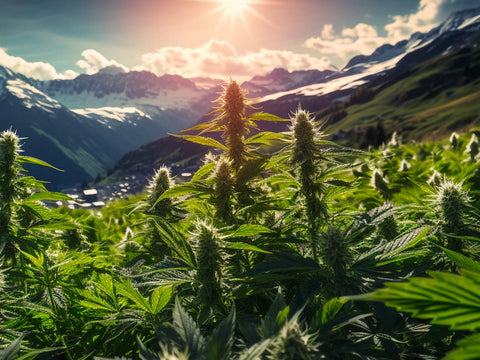CBD flower, as a plant species, is capturing significant attention due to its extraordinary medical and recreational properties. These properties are often attributed to cannabinoids such as THC and CBD; however, there's another group of compounds that play a crucial role in this phenomenon: terpenes.
In this article, we'll delve into the world of cannabis terpenes, discussing their nature, types, and how they work in harmony with other compounds found within the plant.
Terpenes in CBD flower : An Introduction
Terpenes are organic compounds produced by various plants, including cannabis. They are responsible for the distinctive aromas, flavours, and colours of different strains. The term 'terpene' comes from the word "turpentine," which refers to the primary constituent in resinous secretions of coniferous trees. Terpenes serve numerous purposes, including attracting pollinators, repelling predators, and protecting plants against pathogens or environmental stressors.
The Types of Terpenes Found in Cannabis
There are over one hundred identified terpenes in the CBD flower, and each strain has its unique profile. Some of the most common terpenes found in cannabis include:
- Myrcene: Myrcene is the most prevalent terpene in cannabis, contributing to roughly 40% of the total terpene content in some strains. It has an earthy, musky scent similar to cloves and is also present in hops, thyme, and lemongrass.
- Limonene: Limonene has a zesty, citrus scent, and it is not only found in cannabis but also in the rinds of citrus fruits, peppermint, and rosemary. It is considered one of the most potent terpenes due to its fast evaporation rate and strong aroma.
- Caryophyllene: Caryophyllene has a spicy, woody scent similar to black pepper and is present in cloves, cinnamon, and oregano. It is known for being the only terpene to interact with the endocannabinoid system directly, specifically binding to the CB2 receptor.
- Pinene: Pinene is responsible for the familiar pine scent and can be found in coniferous trees, rosemary, and basil. It comes in two isomers – alpha-pinene and beta-pinene – which differ slightly in structure and properties.
- Linalool: Linalool boasts a floral, sweet aroma reminiscent of lavender and is found in CBD flowers such as lavender and geraniums. It plays a unique role in aromatherapy due to its ability to induce relaxation and sedation.
These are just a few examples of the many terpenes that can be found in cannabis plants. Each strain's specific terpene profile contributes to its unique aroma, flavour, and overall experience.
Factors That Influence Terpene Production

Cannabis terpene production is influenced by several factors, which include:
- Genetics: The genetic makeup of a plant determines its potential to produce various terpenes. Some strains are naturally more predisposed to producing specific terpenes than others.
- Growing Conditions: Factors such as temperature, humidity, soil composition, and the availability of nutrients also affect terpene production. Terpenes are sensitive to heat and light, so inadequate conditions can either encourage or discourage their production.
- Plant Maturity: The age at which a cannabis plant is harvested influences its terpene content. During the vegetation stage, terpenes are found within the plant's trichomes but begin degrading as the flowering stage progresses.
Considering these factors allows growers to cultivate strains with targeted terpene profiles to enhance specific flavours, aromas, and other desired properties.
The Synergistic Relationship Between Terpenes and Cannabinoids
Terpenes don't just provide cannabis plants with unique scents and flavours; they also play an essential role in the way compounds like THC and CBD interact with our bodies through a phenomenon known as 'the entourage effect.' This concept refers to the synergistic relationship that exists between cannabinoids, terpenes, and other compounds present in this botanical wonder. Instead of working independently, these elements complement and augment each other's effects, leading to a more balanced and rewarding experience when consumed together.
Modulating the Psychoactive Effects of THC
One of the most crucial roles that terpenes play in the entourage effect is the modulation of THC's psychoactive properties. Some terpenes, such as myrcene and beta-caryophyllene, have been observed to reduce the potential negative side effects associated with THC, including anxiety, paranoia, and cognitive impairment.
Potentiating the Therapeutic Effects of CBD
Terpenes can also impact how cannabinoids interact with the body by modulating receptor affinity, uptake, and metabolism. For instance, some terpenes, like limonene and pinene, can boost CBD's anti-inflammatory and analgesic effects. Other terpenes, such as linalool and caryophyllene, may enhance CBD's ability to alleviate additional symptoms like anxiety or muscle spasms.
Understanding the role that terpenes play in the entourage effect helps users select strains that cater to specific needs. For instance, a strain high in myrcene may be ideal for those seeking relaxation, while strains rich in limonene might better serve individuals looking for an uplifting experience.
How Terpenes Influence Aromatherapy in your CBD flowers
Terpenes have long been used for their aromatic properties, most notably in the field of aromatherapy. Aromatherapy is a holistic healing practice that uses plant-based essential oils to promote health and well-being by stimulating the senses.
The distinctive scents provided by cannabis terpenes can help create calming, invigorating, or focusing environments, depending on the terpene profile of a particular strain. Some common terpene-infused products used in aromatherapy include candles, diffusers, soaps, and skin creams.
In conclusion, terpenes are instrumental compounds that give cannabis its unique character and contribute significantly to its therapeutic potential. By understanding how these organic compounds function, growers and consumers alike can make informed decisions about selecting CBD strains that offer customized experiences aligned with individual preferences and needs.



